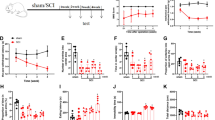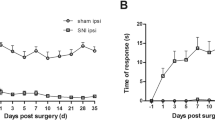Abstract
High mobility group box 1 (HMGB1) released from sensory nerve tissues can induce neuropathic pain. Whether HMGB1 is implicated in the mechanism underlying the effect of lidocaine in pain management remains to be determined. This study aims to explore the effect of lidocaine in a rat model of spared nerve injury (SNI) and the underlying mechanism. An SNI model was established via nerve ligation. Two weeks after the SNI model was established, rats were intrathecally injected with lidocaine, an HMGB1 antibody (HMG Ab), an MIP-1α antibody (MIP-1α Ab), a CCR1 inhibitor (CCR1-RS) or a CCR5 antagonist (CCR5-Mar). Pain behaviors were assessed before and after model establishment to calculate the number of spontaneous flinches (NSF), paw withdrawal threshold (PWT), paw withdrawal thermal latency (PWL) and sciatic function index (SFI). Cell apoptosis and the inflammatory response in the cerebrospinal fluid (CSF) were detected by TUNEL staining and ELISA. The mRNA and protein expression levels of MIP-1α, CCR1 and CCR5 were determined by RT-PCR and Western blotting. The expression levels of HMGB1, MIP-1α, CCR1 and CCR5 were measured by Western blotting and immunofluorescence. Pain behavior testing in SNI rats showed that SNI rats exhibited an increased NSF and a decreased PWT, PWL and SFI. Cell apoptosis in the spinal dorsal horn and the generation of inflammatory cytokines were enhanced in SNI rats, and the expression levels of HMGB1, MIP-1α, CCR1 and CCR5 were upregulated. HMGB1 cytoplasmic translocation, the coexpression of MIP-1α with NeuN, and the coexpression of CCR1 and CCR5 with OX42 were also observed in SNI rats. Neuropathic pain and neuroinflammation were suppressed by the intrathecal injection of lidocaine, HMG Ab, MIP-1α Ab, CCR1-RS or CCR5-Mar. Lidocaine inhibited the expression levels of HMGB1, MIP-1α, CCR1 and CCR5, and the HMGB1 antibody suppressed the expression of MIP-1α, CCR1 and CCR5. Lidocaine attenuates neuropathic pain and neuroinflammation by inhibiting HMGB1 to regulate the MIP-1α/CCR1/CCR5 pathway.

Graphical Abstract









Similar content being viewed by others
References
Abraham E, Arcaroli J, Carmody A, Wang H, Tracey KJ (2000) HMG-1 as a mediator of acute lung inflammation. J Immunol 165:2950–2954
Agalave NM, Svensson CI (2015) Extracellular high-mobility group box 1 protein (HMGB1) as a mediator of persistent pain. Mol Med 20:569–578
An K, Rong H, Ni H, Zhu C, Xu L, Liu Q, Chen Y, Zheng Y, Huang B, Yao M (2018) Spinal PKC activation - induced neuronal HMGB1 translocation contributes to hyperalgesia in a bone cancer pain model in rats. Exp Neurol 303:80–94
Aucott H, Lundberg J, Salo H, Klevenvall L, Damberg P, Ottosson L, Andersson U, Holmin S, Erlandsson Harris H (2018) Neuroinflammation in response to Intracerebral injections of different HMGB1 redox isoforms. J Innate Immun 10:215–227
Bouhassira D, Lanteri-Minet M, Attal N, Laurent B, Touboul C (2008) Prevalence of chronic pain with neuropathic characteristics in the general population. Pain 136:380–387
Fernandes V, Sharma D, Vaidya S, P AS, Guan Y, Kalia K, Tiwari V (2018) Cellular and molecular mechanisms driving neuropathic pain: recent advancements and challenges. Expert Opin Ther Targets 22:131–142
Gilron I, Baron R, Jensen T (2015) Neuropathic pain: principles of diagnosis and treatment. Mayo Clin Proc 90:532–545
Gui Y, Duan S, Xiao L, Tang J, Li A (2019) Bexarotent attenuated CCI-induced spinal neuroinflammation and neuropathic pain by targeting MKP-1. J Pain Jan 17:11–32
Hermanns H, Hollmann MW, Stevens MF, Lirk P, Brandenburger T, Piegeler T, Werdehausen R (2019) Molecular mechanisms of action of systemic lidocaine in acute and chronic pain: a narrative review. Br J Anaesth 123(3):3351–349
Kanegasaki S, Matsushima K, Shiraishi K, Nakagawa K, Tsuchiya T (2014) Macrophage inflammatory protein derivative ECI301 enhances the alarmin-associated abscopal benefits of tumor radiotherapy. Cancer Res 74:5070–5078
Kiguchi N, Maeda T, Kobayashi Y, Fukazawa Y, Kishioka S (2010) Macrophage inflammatory protein-1alpha mediates the development of neuropathic pain following peripheral nerve injury through interleukin-1beta up-regulation. Pain 149:305–315
Kiguchi N, Kobayashi Y, Kishioka S (2012) Chemokines and cytokines in neuroinflammation leading to neuropathic pain. Curr Opin Pharmacol 12:55–61
Kiguchi N, Kobayashi D, Saika F, Matsuzaki S, Kishioka S (2018) Inhibition of peripheral macrophages by nicotinic acetylcholine receptor agonists suppresses spinal microglial activation and neuropathic pain in mice with peripheral nerve injury. J Neuroinflammation 15:96
Kim S, Kim SY, Pribis JP, Lotze M, Mollen KP, Shapiro R, Loughran P, Scott MJ, Billiar TR (2013) Signaling of high mobility group box 1 (HMGB1) through toll-like receptor 4 in macrophages requires CD14. Mol Med 19:88–98
Kim HS, Ryu KJ, Ko YH, Kim HJ, Kim SH, Kim WS, Kim SJ (2017) Macrophage inflammatory protein 1 alpha (MIP-1alpha) may be associated with poor outcome in patients with extranodal NK/T-cell lymphoma. Hematol Oncol 35:310–316
Kwiatkowski K, Popiolek-Barczyk K, Piotrowska A, Rojewska E, Ciapala K, Makuch W, Mika J (2019) Chemokines CCL2 and CCL7, but not CCL12, play a significant role in the development of pain-related behavior and opioid-induced analgesia. Cytokine 119:202–213
Liu F, Wang Z, Qiu Y, Wei M, Li C, Xie Y, Shen L, Huang Y, Ma C (2017) Suppression of MyD88-dependent signaling alleviates neuropathic pain induced by peripheral nerve injury in the rat. J Neuroinflammation 14:70
Matsushita K, Tozaki-Saitoh H, Kojima C, Masuda T, Tsuda M, Inoue K, Hoka S (2014) Chemokine (C-C motif) receptor 5 is an important pathological regulator in the development and maintenance of neuropathic pain. Anesthesiology 120:1491–1503
Moore D, Chong MS, Shetty A, Zakrzewska JM (2019) A systematic review of rescue analgesic strategies in acute exacerbations of primary trigeminal neuralgia. Br J Anaesth 123:e385–e396
Rong H, Zhao Z, Feng J, Lei Y, Wu H, Sun R, Zhang Z, Hou B, Zhang W, Sun Y, Gu X, Ma Z, Liu Y (2017) The effects of dexmedetomidine pretreatment on the pro- and anti-inflammation systems after spinal cord injury in rats. Brain Behav Immun 64:195–207
Shibasaki M, Sasaki M, Miura M, Mizukoshi K, Ueno H, Hashimoto S, Tanaka Y, Amaya F (2010) Induction of high mobility group box-1 in dorsal root ganglion contributes to pain hypersensitivity after peripheral nerve injury. Pain 149:514–521
Su D, Gu Y, Wang Z, Wang X (2010) Lidocaine attenuates proinflammatory cytokine production induced by extracellular adenosine triphosphate in cultured rat microglia. Anesth Analg 111:768–774
Sun H, Sun Y (2019) Lidocaine inhibits proliferation and metastasis of lung cancer cell via regulation of miR-539/EGFR axis. Artif Cells Nanomed Biotechnol 47:2866–2874
Sun S, Chen D, Lin F, Chen M, Yu H, Hou L, Li C (2016) Role of interleukin-4, the chemokine CCL3 and its receptor CCR5 in neuropathic pain. Mol Immunol 77:184–192
Tong W, Wang W, Huang J, Ren N, Wu SX, Li YQ (2010) Spinal high-mobility group box 1 contributes to mechanical allodynia in a rat model of bone cancer pain. Biochem Biophys Res Commun 395:572–576
Torrance N, Smith BH, Bennett MI, Lee AJ (2006) The epidemiology of chronic pain of predominantly neuropathic origin. Results from a general population survey J Pain 7:281–289
Wang HL, Zhang WH, Lei WF, Zhou CQ, Ye T (2011) The inhibitory effect of lidocaine on the release of high mobility group box 1 in lipopolysaccharide-stimulated macrophages. Anesth Analg 112:839–844
Wang HL, Xing YQ, Xu YX, Rong F, Lei WF, Zhang WH (2013) The protective effect of lidocaine on septic rats via the inhibition of high mobility group box 1 expression and NF-kappaB activation. Mediat Inflamm 2013:570370
Wang L, Wang T, Li H, Liu Q, Zhang Z, Xie W, Feng Y, Socorburam T, Wu G, Xia Z, Wu Q (2016) Receptor interacting protein 3-mediated Necroptosis promotes lipopolysaccharide-induced inflammation and acute respiratory distress syndrome in mice. PLoS One 11:e0155723
Wenzhao L, Jiangdong N, Deye S, Muliang D, Junjie W, Xianzhe H, Mingming Y, Jun H (2019) Dual regulatory roles of HMGB1 in inflammatory reaction of chondrocyte cells and mice. Cell Cycle 18(18):11–13
Zheng Y, Hou X, Yang S (2019) Lidocaine Potentiates SOCS3 to Attenuate Inflammation in Microglia and Suppress Neuropathic Pain. Cell Mol Neurobiol 39(8):11–12
Zhong Y, Chen J, Chen J, Chen Y, Li L, Xie Y (2019) Crosstalk between Cdk5/p35 and ERK1/2 signalling mediates spinal astrocyte activity via the PPARgamma pathway in a rat model of chronic constriction injury. J Neurochem 151(2):1661–184
Zhou LJ, Peng J, Xu YN, Zeng WJ, Zhang J, Wei X, Mai CL, Lin ZJ, Liu Y, Murugan M, Eyo UB, Umpierre AD, Xin WJ, Chen T, Li M, Wang H, Richardson JR, Tan Z, Liu XG, Wu LJ (2019) Microglia are indispensable for synaptic plasticity in the spinal dorsal horn and chronic pain. Cell Rep 27(3844–3859):e3846
Author information
Authors and Affiliations
Corresponding author
Additional information
Publisher’s Note
Springer Nature remains neutral with regard to jurisdictional claims in published maps and institutional affiliations.
Mingming Li and Hao Jiang are co-first authors.
Rights and permissions
About this article
Cite this article
Li, M., Jiang, H., Gu, K. et al. Lidocaine Alleviates Neuropathic Pain and Neuroinflammation by Inhibiting HMGB1 Expression to Mediate MIP-1α/CCR1 Pathway. J Neuroimmune Pharmacol 16, 318–333 (2021). https://doi.org/10.1007/s11481-020-09913-y
Received:
Accepted:
Published:
Issue Date:
DOI: https://doi.org/10.1007/s11481-020-09913-y




